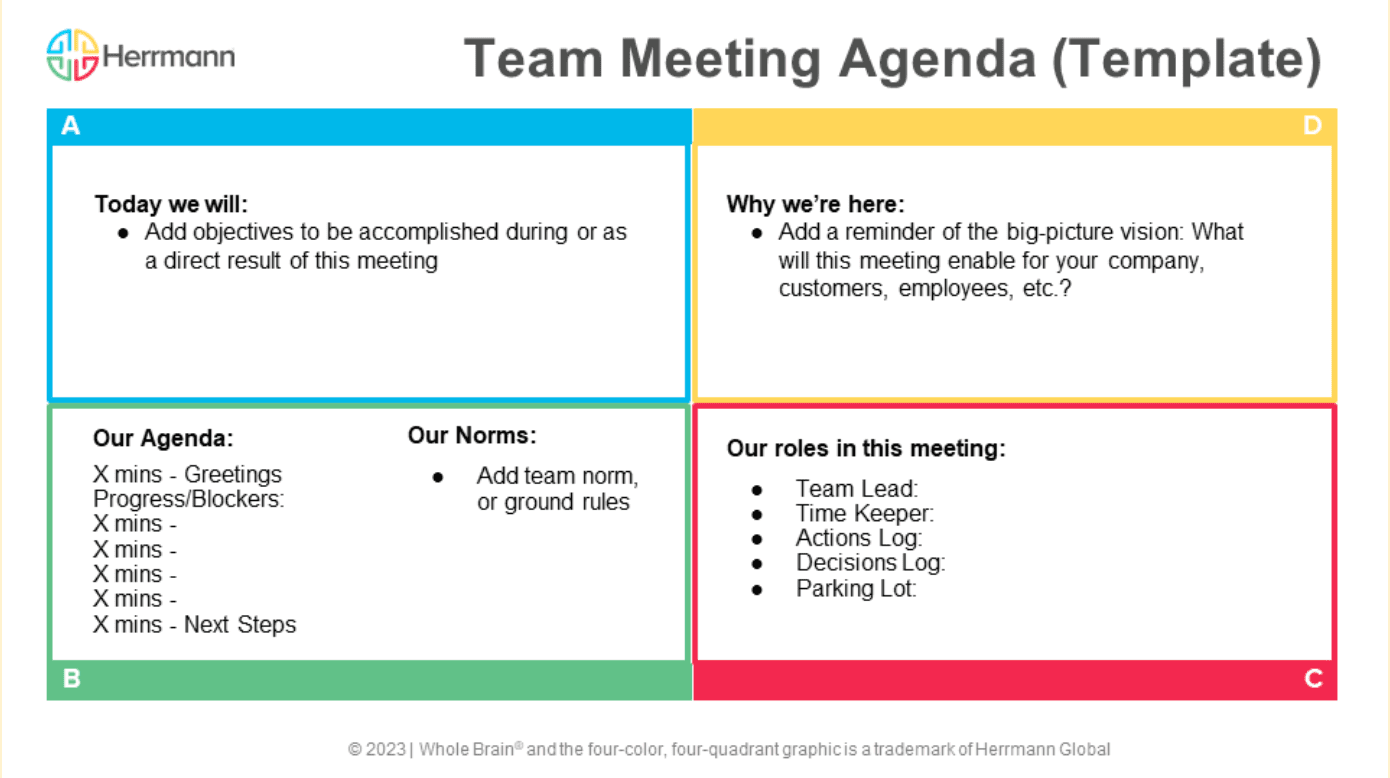Too many meetings are unproductive, uninspiring, and even damaging to morale. One common reason is because employees don’t understand why they’re in the meeting or what they’re supposed to accomplish. Creating a team meeting agenda can prevent this problem and empower your employees to collaborate, learn from each other, and find better solutions to thorny problems.
An agenda serves as the meeting's road map — outlining discussion topics, setting expectations, and keeping everyone focused. Meetings with no agenda are one of the biggest frustrations for employees — second only to meetings that start late. And when employees don’t know why they’re meeting, they probably won’t get much done. That compounds the frustration that’s all too common, with employees wasting 31 hours each month in unproductive meetings.
Learn why agendas are so important and how to create one for your next meeting. We’ll also share a template that can help you standardize recurring meetings within your team.
Why Is a Team Meeting Agenda Important?
Meetings can be powerful drivers of collaboration and results or blockers that drain people’s energy and keep them from making progress elsewhere. Like with any work task, you’re likely to perform better when you understand what you’re doing, why, who else is involved, and what you expect to achieve.
Agendas set the stage for productive meetings by:
- Naming the key topics: Being clear about the discussion topics lets participants prepare and, if necessary, suggest additional or alternate topics.
- Assigning roles: Knowing assignments helps everyone, especially if you’re supposed to facilitate the meeting or give a presentation.
- Organizing everyone’s time: A preview of the meeting agenda can help participants organize their thoughts. If they have competing obligations, the agenda can help them determine whether this meeting is truly their priority — or whether they should decline or send someone in their place.
- Recording for future reference: Everyone is busy, and having the agenda handy prevents constant questions and confusion. Keeping a historical record of meeting agendas and outcomes can help people who miss the meeting, not to mention, inform future meetings.
- Rejuvenating recurring meetings: If you have a weekly team meeting, for example, it’s easy for it to become stale or devolve into status updates that could be sent via email. An agenda elevates the conversation and forces participants to regularly assess why they’re meeting (and whether they should).
.png?width=1200&height=627&name=Herrmann_MeetingAgendasinternalimage_BenefitsofMeetingAgendas%20(1).png)
6 Steps to Creating a Team Meeting Agenda
Your agenda doesn’t have to be complicated, especially when you understand the basics. Here are the steps to creating an efficient and effective team meeting agenda.
Identify the Objectives
Before drafting an agenda, think about what you want to accomplish. Ask yourself questions like:
- What topics need to be discussed?
- What decisions do we need to make?
- What information must be shared ahead of time and during the meeting?
- Who should be invited?
- Who needs to weigh in on the agenda?
- What resources are needed to hold this meeting?
Answering these straightforward questions helps you define the meeting and ensure you haven’t missed any obvious needs. Once you have identified these objectives, you can begin crafting a more detailed agenda and gathering the required information, people, and resources.
Establish Meeting Norms
Team meetings should be a welcoming environment where participants can have honest, even vulnerable discussions. This requires agreement on the meeting’s form, tone, and other rules.
For instance, a meeting with scheduled speakers might leave room for questions at the end rather than having participants interrupt throughout. Another type of team meeting might focus on collaborative brainstorming and thus allow for much more interactive discussion.
Be extra clear about norms or rules that are changing for a particular meeting — for instance, a discussion of nonpublic, confidential information, or a meeting that’s occurring at a different time or place.
Look to your organization’s values to further inform the tone and tenor of meetings, such as asking everyone to turn off or silence their phones before the meeting begins. In all cases, establish an atmosphere of respect, openness, collaboration, and trust. Encourage everyone to share their ideas without judgment and embrace the cognitive diversity in the room.
Solicit Agenda Topics
Some meetings might have a standing topic, but many team meetings are driven by your employees based on what they’re working on or the challenges they wish to discuss.
Create a process where team members can suggest topics or give feedback on the proposed agenda. Ensure that the meeting organizer, facilitator, and any scheduled speakers or presenters are aware of the agenda topics and can provide their input.
Draft the Agenda
Your draft agenda should include key information about the meeting’s time, location, and length as well as a list of the topics to be discussed, key meeting personnel, and the hoped-for outcomes.
As you draft your agenda, assign an estimated time for each meeting topic to help you keep on schedule. This will help you understand whether some topics need to be shortened or held for another time. Make sure to leave at least a few minutes for questions.
At this point, key stakeholders can review the agenda, offer edits, or sign off. For recurring meetings, this level of review might be less necessary, but it always helps to have a second set of eyes on the agenda before distributing it.
Share the Agenda Before the Meeting
Finally, distribute the finalized agenda beforehand so everyone can come prepared with their thoughts and ideas. No one should be surprised by the discussion topics or their role in the meeting. This is one of the simplest ways to create meetings people won’t hate.
Build Templates for Recurring Meetings
Save yourself and your team time and effort by creating templates for common or recurring meetings. While the particulars of the agenda will need to be updated, keeping the same process and structure provides continuity and familiarity.
.png?width=1200&height=627&name=Herrmann_MeetingAgendasinternalimage_6StepstoCreatingaTeamMeetingAgenda%20(1).png)
How to Incorporate Whole Brain® Thinking Into Your Meeting Agenda
Just as everyone has diverse characteristics, such as race, gender, ethnicity, and cultural background, we also have cognitive diversity or diversity of thought. This means that everyone has a distinct set of thinking preferences that influence how we approach the world.
The good news is that those thinking preferences are measurable through the Herrmann Brain Dominance Instrument (HBDI®) assessment. You can understand your thinking preferences and your team's through the Whole Brain® Thinking framework — and apply it to day-to-day work, including meetings.
The Whole Brain® Thinking model groups people’s thinking preferences into four quadrants: Analytical (Blue), Structural (Green), Relational (Red), and Experimental (Yellow). Whole Brain® Thinking is about preference, not competence. Everybody can and does use all four thinking preferences daily, and there’s no ideal or best combination.
Meeting agendas are a very Structural (Green) activity. You’re explicitly bringing structure, organization, and planning to your team’s activity. But creating an agenda accesses all four quadrants of Whole Brain® Thinking.

For example, meeting agendas should include discussion points and objectives, such as action items. Organizing this information accesses the Structural (Green) quadrant, but this also is straightforward, analytical data that helps Blue thinkers see what will be accomplished. Sharing meeting objectives also helps people feel included and informed (Red) and frees up your team to think big about possibilities (Yellow).
Sharing the meeting norms and rules adds structure and organization (Green) while ensuring all participants understand how they’ll be expected to treat each other (Red). Similarly, soliciting ideas for the agenda ensures you capture a variety of ideas and perspectives (Yellow), including people who might otherwise not speak up (Red).
When you design and lead a meeting with only your own preferences in mind, you’re bound to lose those who aren’t on your thinking wavelength. A comprehensive meeting agenda brings different perspectives to the table and gives them a framework for adding their cognitive diversity while learning from their colleagues.
Team Meeting Agenda Template
There are many ways to organize your meeting agenda. Feel free to experiment — the format that works for your monthly team check-in might differ from a product-focused meeting or a conversation between a manager and an employee. One place to find a sample agenda for a team meeting is within your organization. Look at what productive teams and well-respected leaders do, and adapt from there.
Below is just one example of a team meeting agenda template:
Date: ___________________ Time: ___________________
Meeting Facilitator: ___________________
Attendees: ___________________
Introduction (5 minutes)
- Welcome and introductions
- Goals and purpose of the meeting
- Ground rules
Agenda Items (each with time allotted)
- ____________________________
- ____________________________
- ____________________________
Open Discussion (X minutes)
Action Items/Decision-Making (each with time allotted)
____________________________
____________________________
____________________________
Wrap-Up (5 minutes)
- Review action items
- Next steps
- Additional comments or questions
Plan Better Team Meetings
Every meeting should have a purpose, and the agenda is a simple, effective way to define that purpose for every attendee before you gather. When you create a team meeting agenda, you show consideration for your employees and help them focus on bringing their best selves to the meeting.
Take the next step toward effective meetings by implementing Whole Brain® Thinking to your meetings, starting with the agenda. When you embrace cognitive diversity in your team, you’ll find meetings are better organized, structured, and carried out.
Are you looking for more tips for better meetings? Download our Meetings That Work toolkit.


-1.jpg?width=1200&name=Herrmann%20-%20Meeting%20Agendas%20-%20Featured%20image%20(1)-1.jpg)









